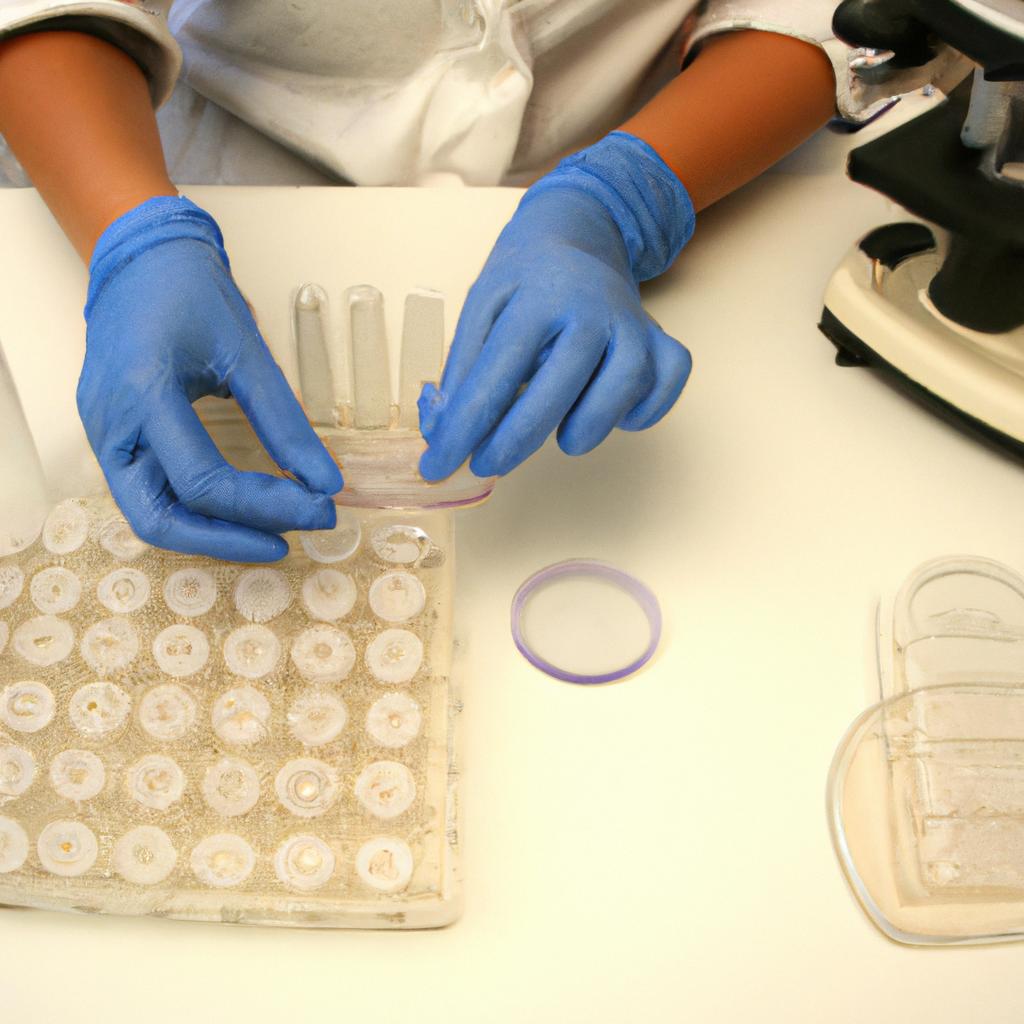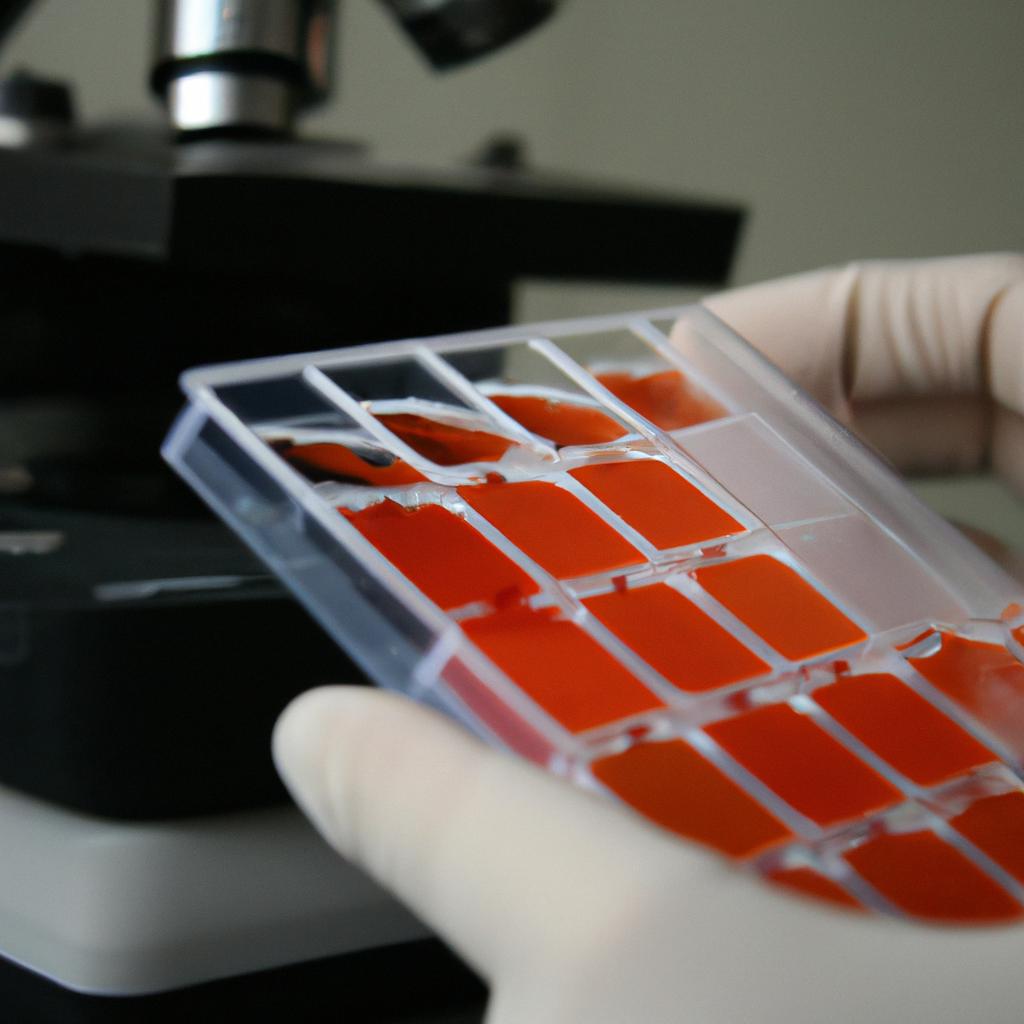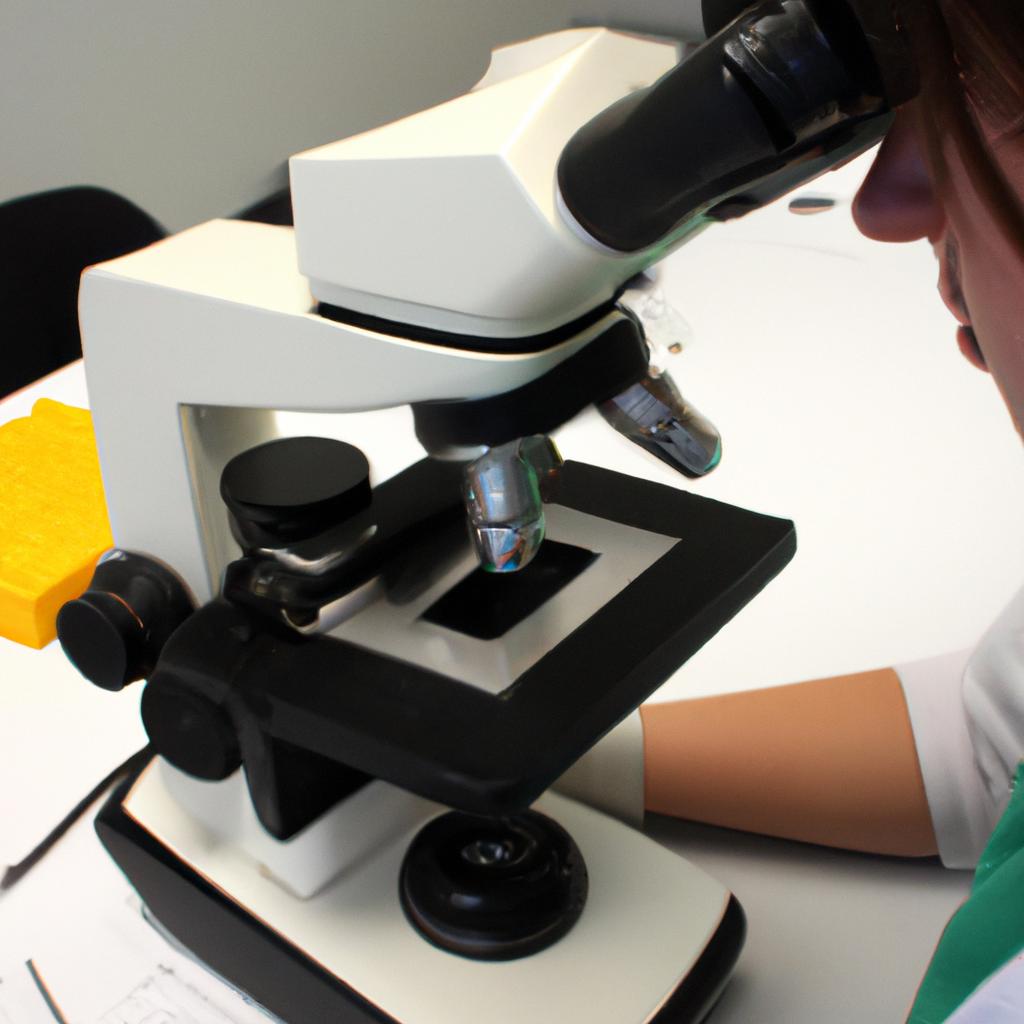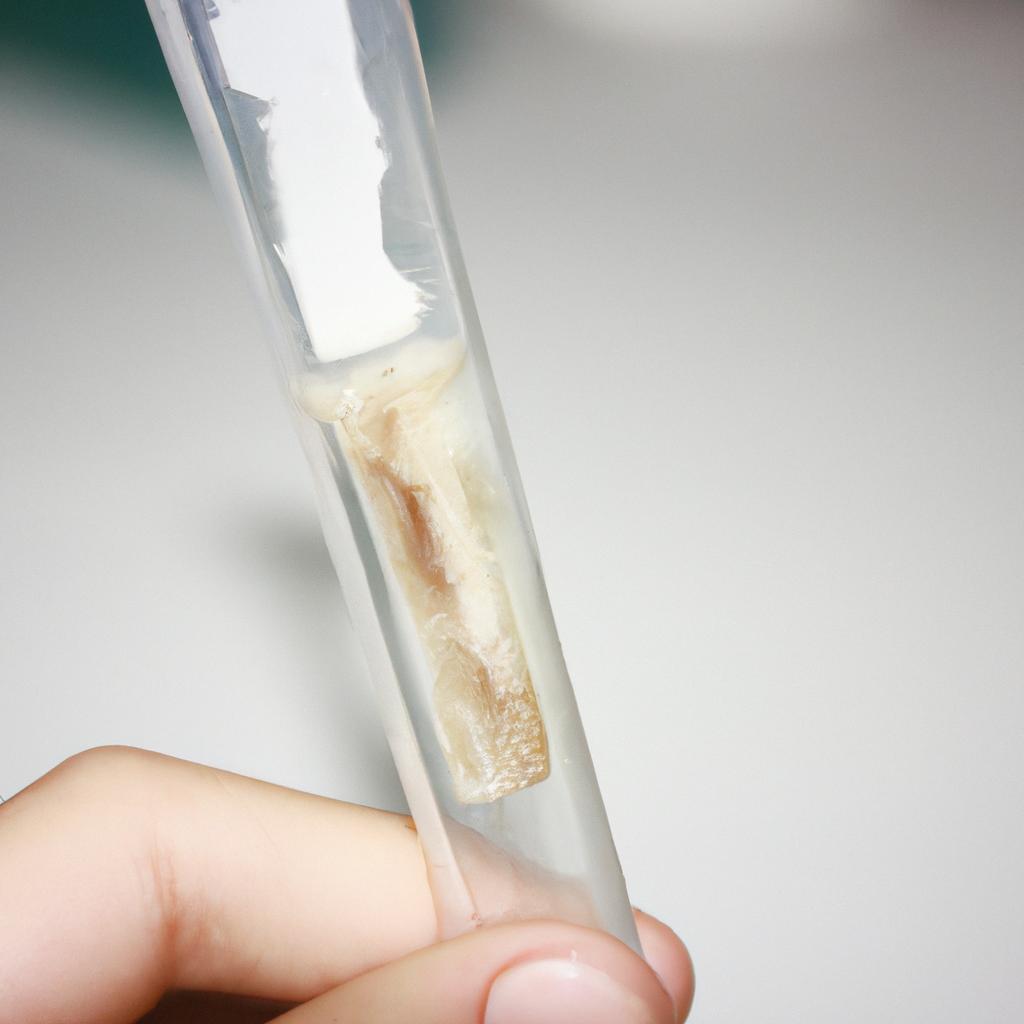Platelet count plays a crucial role in veterinary clinical pathology, providing essential information about an animal’s health status and aiding in the diagnosis of various hematological disorders. Understanding platelet count involves assessing both quantitative and qualitative aspects, which require comprehensive evaluation through meticulous laboratory techniques. This article aims to provide a comprehensive guide to hematological evaluation focusing on platelet count in veterinary medicine.
Consider the hypothetical case of a 6-year-old German Shepherd presenting with unexplained bruising and prolonged bleeding after minor injuries. The veterinarian suspects a potential platelet disorder and decides to conduct a thorough hematological evaluation, including platelet count assessment. Platelets, small cellular fragments derived from megakaryocytes, are fundamental for hemostasis as they form primary clots at sites of vascular injury. Any abnormality or deficiency in platelets can significantly impact an animal’s ability to control bleeding and may indicate underlying pathologies such as immune-mediated thrombocytopenia or inherited platelet function disorders.
Accurate interpretation of platelet counts requires understanding not only their numerical values but also their morphology and functionality within the context of other blood parameters. Thus, this article will delve into the methods employed for precise measurement of platelet count, highlight key factors affecting its accuracy, discuss normal ranges for different species, and explore the significance of platelet morphological abnormalities.
In veterinary medicine, platelet counts are typically measured using automated hematology analyzers. These instruments utilize either impedance or optical methods to estimate platelet numbers in a given blood sample. Impedance-based analyzers pass the blood through an aperture and measure changes in electrical resistance caused by individual platelets passing through the aperture. Optical methods, on the other hand, use light scatter patterns to identify and count platelets. Both techniques have their advantages and limitations, and it is important for veterinarians to be aware of these factors when interpreting platelet counts.
Several factors can influence the accuracy of platelet counts. One such factor is clumping of platelets, which can occur in certain conditions such as immune-mediated thrombocytopenia or due to improper sample handling. Platelet clumps can mistakenly be counted as single platelets by automated analyzers, leading to falsely elevated results. To mitigate this issue, technicians may perform manual platelet estimates using a blood smear examination under a microscope.
It is crucial to consider species-specific variations in normal platelet counts when interpreting results. For example, dogs generally have higher platelet counts than cats or horses. Additionally, some animals may naturally exhibit lower baseline levels of circulating platelets compared to others without any underlying pathology.
Moreover, evaluating the morphology of platelets is essential for accurate interpretation of hematological disorders. Platelet morphological abnormalities can include changes in size (e.g., giant platelets), shape (e.g., spiculated or elongated forms), or granulation patterns (e.g., hypogranular or hypergranular). These abnormalities may indicate various pathologies such as inherited disorders like von Willebrand disease or acquired conditions like myeloproliferative neoplasms.
In conclusion, understanding and accurately interpreting platelet counts are essential aspects of veterinary clinical pathology. Precise measurement of platelet numbers, consideration of species-specific variations, and evaluation of platelet morphology are all crucial components of a comprehensive hematological assessment. By utilizing these techniques, veterinarians can diagnose and manage various hematological disorders affecting their patients’ overall health and well-being.
Principles of Platelet Count
Imagine a scenario where a veterinarian receives a blood sample from a dog exhibiting symptoms of excessive bleeding and bruising. The vet suspects a possible platelet disorder, which prompts them to perform a platelet count as part of the hematological evaluation. Platelet count is an essential component in veterinary clinical pathology, providing valuable information about hemostasis and potential underlying health conditions affecting the patient.
To understand the principles behind platelet count, it is crucial to first define what platelets are and their role in the body. Platelets, also known as thrombocytes, are small cellular fragments produced in the bone marrow that play a vital role in clot formation during bleeding events. Monitoring platelet levels can help diagnose various disorders such as immune-mediated thrombocytopenia or inherited coagulation abnormalities.
When performing a platelet count, veterinarians use different methods based on their specific laboratory equipment and expertise. These methods include automated analyzers utilizing impedance or optical technology, manual counting using microscopy techniques like phase contrast or oil immersion, and flow cytometry-based approaches. Each method has its advantages and limitations regarding accuracy, precision, cost-effectiveness, and turnaround time.
Understanding the significance of accurate platelet counts goes beyond routine diagnostic purposes; it allows for proper management decisions when treating patients with bleeding disorders. A decreased platelet count indicates thrombocytopenia and may require further investigation to determine the cause. On the other hand, an elevated platelet count might be indicative of reactive thrombocytosis secondary to inflammation or underlying diseases such as neoplasia or infection.
In summary, accurate determination of platelet count provides critical insight into a patient’s overall health status by evaluating their ability to form clots effectively. This knowledge aids veterinarians in diagnosing potential disorders related to hemostasis abnormalities promptly. In the subsequent section on “Types of Platelet Count Methods,” we will explore the different techniques employed in evaluating platelet counts, further enhancing our understanding of this essential diagnostic tool.
Types of Platelet Count Methods
Platelet Count Methods in Veterinary Clinical Pathology
In the previous section, we discussed the principles underlying platelet count measurements. Now, let’s delve into the different methods used to determine platelet counts in veterinary clinical pathology. To illustrate the practical application of these methods, consider a hypothetical case study involving a dog presented with unexplained bleeding tendencies.
There are several techniques available for assessing platelet counts in veterinary medicine. These include manual counting using hemocytometers or blood films, automated cell counters, and flow cytometry-based assays. Each method has its advantages and limitations, which need to be considered when evaluating platelet numbers in clinical practice.
Firstly, manual counting is a time-consuming process that requires skilled technicians to observe blood smears under a microscope and manually tally individual platelets. Although it provides accurate results when performed meticulously, manual counting may introduce interobserver variability due to human error or subjective interpretation.
Alternatively, automated cell counters offer faster and more efficient platelet count measurements by utilizing electronic impedance or optical scatter technologies. These systems provide rapid and reliable results but can sometimes underestimate or overestimate platelet counts if there are abnormalities present in the sample (e.g., clumped platelets).
Lastly, flow cytometry-based assays utilize fluorescently labeled antibodies specific for platelet surface markers to identify and quantify platelets within a heterogeneous population of cells. This technique offers high specificity and sensitivity while providing additional information about platelet size and activation status.
- Accurate evaluation of platelet counts aids in diagnosing various conditions such as immune-mediated thrombocytopenia.
- Timely identification of thrombocytopenia assists clinicians in implementing appropriate treatment strategies.
- Reliable assessment of post-transfusion responses ensures effective management of patients undergoing transfusion therapy.
- Monitoring changes in platelet counts during therapeutic interventions helps evaluate treatment efficacy and disease progression.
Moreover, the table below summarizes the advantages and limitations of different platelet count methods:
| Method | Advantages | Limitations |
|---|---|---|
| Manual counting | Accurate results when performed meticulously | Time-consuming process |
| Automated counters | Fast and efficient | May underestimate or overestimate counts in certain samples |
| Flow cytometry | Provides additional information about size and activation | Requires specialized equipment and expertise |
In conclusion, selecting an appropriate method for evaluating platelet counts is crucial in veterinary clinical pathology. Understanding the strengths and weaknesses of each technique allows clinicians to make informed decisions regarding patient management. In the subsequent section, we will explore normal platelet counts in different animal species, providing valuable reference values for accurate interpretation of hematological evaluations.
Normal Platelet Count in Different Animal Species
Now that we have discussed the various types of platelet count methods used in veterinary clinical pathology, let us delve into understanding what constitutes a normal platelet count in different animal species. To better illustrate this, consider the following scenario:
Imagine a veterinarian examining a young Labrador Retriever with symptoms of unexplained bleeding and bruising. The first step in the diagnostic process would be to perform a complete blood count (CBC), which includes assessing the platelet count. This simple yet crucial test provides valuable information about the dog’s overall health and helps identify potential underlying disorders.
When evaluating platelet counts in animals, it is important to keep in mind that reference ranges can vary across species due to physiological differences. Here are some general guidelines for normal platelet counts in common domesticated animals:
- Dogs: A typical range for dogs is 150,000 to 400,000 platelets per microliter of blood.
- Cats: Similar to dogs, cats usually exhibit platelet counts within the range of 150,000 to 400,000 per microliter.
- Horses: Equine platelet counts may fall between 100,000 and 500,000 per microliter.
- Cattle: In cattle, the average range is wider compared to other species and varies from approximately 200,000 to 600,000 per microliter.
Understanding these baseline values allows veterinarians to accurately interpret platelet counts and detect deviations from normal levels. By comparing an individual animal’s results with established reference ranges specific to their species, clinicians can gain insights into potential abnormalities or diseases affecting hemostasis.
Understanding the causes behind low platelet counts enables appropriate treatment strategies to be implemented, ensuring the best possible care for our animal companions.
Causes of Low Platelet Count in Animals
Section Title: Understanding Platelet Function in Veterinary Clinical Pathology
Imagine a scenario where a veterinarian receives the blood test results of a dog exhibiting symptoms such as uncontrolled bleeding and bruising. The platelet count, an important parameter for assessing hemostasis, is found to be significantly lower than the normal range. To comprehend the significance of this finding, it is essential to understand the role of platelets in various animal species.
Platelets are small, disc-shaped cellular fragments that play a crucial role in clot formation and wound healing. They circulate in the bloodstream and respond rapidly to vascular injuries by adhering to damaged blood vessels and forming clumps or aggregates known as thrombi. In veterinary clinical pathology, evaluating the platelet count aids in diagnosing conditions associated with abnormal coagulation processes.
Understanding how platelet counts differ across different animal species allows veterinarians to interpret laboratory findings accurately. While dogs typically have higher platelet counts compared to cats, rabbits exhibit an even wider range depending on their breed and individual physiology. For instance, Greyhounds generally display lower baseline platelet counts compared to other canine breeds due to physiological variations.
To illustrate further differences across animals, consider the following bullet-point list:
- Horses usually possess larger-sized platelets compared to small companion animals like cats or dogs.
- Birds tend to have nucleated thrombocytes instead of true platelets.
- Exotic mammals such as ferrets might showcase unique morphological characteristics of their platelets.
In addition to understanding these inter-species variations, interpreting lab reports requires knowledge about different reference ranges for each species. This information can help identify potential health issues more effectively. A comprehensive table summarizing typical platelet counts observed among common domestic animals is provided below:
| Animal Species | Normal Platelet Count Range |
|---|---|
| Dog | 150,000 – 400,000 |
| Cat | 200,000 – 500,000 |
| Horse | 100,000 – 400,000 |
| Rabbit | 200,000 – 600,000 |
In conclusion, evaluating platelet counts in veterinary clinical pathology is essential for diagnosing and managing various coagulation disorders. Understanding the normal range of platelet counts in different animal species allows for accurate interpretation of laboratory results. By recognizing inter-species variations and reference ranges specific to each species, veterinarians can effectively identify potential health issues in their patients.
Transition Sentence: Now let’s explore the causes of high platelet count in animals.
Causes of High Platelet Count in Animals
Platelet count abnormalities can provide valuable insights into an animal’s health status, and a high platelet count, also known as thrombocytosis, is no exception. Understanding the underlying causes of thrombocytosis plays a crucial role in diagnosing and managing various veterinary conditions. To illustrate this further, let us consider the case of a 10-year-old feline patient who presented with persistent bleeding from minor wounds despite normal clotting times.
There are several potential reasons for elevated platelet counts in animals. Firstly, inflammation or infection may stimulate the production and release of platelets by the bone marrow as part of the body’s defense mechanism. In our feline patient’s case, it was discovered that she had recently recovered from an upper respiratory tract infection, suggesting that her thrombocytosis could be reactive to the previous inflammatory condition.
Secondly, certain neoplastic disorders such as myeloproliferative diseases can lead to increased platelet production. These conditions involve abnormal growth and proliferation of cells within the bone marrow, resulting in excessive formation of platelets. Although rare in cats, these neoplasms should not be overlooked when investigating cases of thrombocytosis.
Thirdly, some parasitic infections can cause an elevation in platelet counts due to their impact on the immune response. For example, tick-borne diseases like ehrlichiosis have been associated with thrombocytosis in dogs. Infection-induced stimulation of megakaryocytes (platelet precursor cells) contributes to increased platelet production and subsequent higher circulating levels.
Lastly, stress-related factors can influence platelet counts. Stressors such as pain or anxiety trigger physiological responses that activate blood clotting mechanisms including platelet aggregation—a process which leads to temporary increases in platelet numbers. It is important for veterinarians to assess if any recent stressful events or environmental changes have occurred in an animal’s life before making a definitive diagnosis.
To better understand the causes of high platelet counts, refer to the following bullet list:
- Inflammation or infection
- Neoplastic disorders/myeloproliferative diseases
- Parasitic infections (e.g., tick-borne diseases)
- Stress-related factors
In addition to these potential causes, it is essential to evaluate other parameters such as red blood cell and white blood cell abnormalities when interpreting thrombocytosis. Understanding the intricate relationships between various hematological components can facilitate accurate diagnoses and appropriate treatment plans for animals displaying high platelet counts.
Transitioning into the subsequent section about the significance of platelet count in veterinary medicine, veterinarians rely on comprehensive evaluations to detect alterations in platelet numbers that may indicate underlying health conditions. By recognizing both low and high platelet counts, professionals can effectively manage and treat their patients’ medical needs while ensuring optimal outcomes.
Significance of Platelet Count in Veterinary Medicine
Understanding the causes behind a high platelet count is crucial for accurate hematological evaluation in veterinary medicine. Now, let us explore the significance of platelet count and its clinical implications.
To illustrate the importance of platelet count assessment, consider a hypothetical case study involving a 7-year-old Labrador Retriever presenting with unexplained bleeding tendencies. Despite no visible external trauma, blood work revealed an abnormally low platelet count. This finding immediately raised concerns regarding possible thrombocytopenia-induced coagulopathies or underlying systemic diseases.
The platelet count serves as a valuable diagnostic tool for various conditions within veterinary medicine. Its significance lies not only in identifying potential hematologic disorders but also aiding in differential diagnoses. When evaluating hematopoietic neoplasms or immune-mediated thrombocytopenias, alterations in platelet counts can provide essential clues for reaching an accurate diagnosis.
Furthermore, monitoring changes in platelet counts during treatment allows veterinarians to assess therapeutic responses and adjust management strategies accordingly. Regular platelet count evaluations are particularly important when managing patients undergoing chemotherapy or immunosuppressive therapy to mitigate risks associated with drug-induced myelotoxicity.
Emotional bullet point list (markdown format):
- Early detection of abnormal platelet counts plays a vital role in preventing life-threatening hemorrhage.
- Accurate determination of thrombocytopenia aids efficient diagnosis and targeted treatments.
- Monitoring changes in platelets helps evaluate response to therapy and guide subsequent interventions.
- Reliable recognition of altered platelet levels assists in distinguishing between primary hematologic disorders and secondary manifestations due to other pathologies.
Emotional table (markdown format):
| Benefits of Platelet Count Evaluation |
|---|
| Early detection and prevention of hemorrhage |
| Efficient diagnosis and targeted treatments |
| Monitoring treatment response for appropriate interventions |
| Distinguishing primary hematologic disorders from secondary manifestations |
In conclusion, the platelet count holds significant clinical value in veterinary medicine. Through its evaluation, veterinarians can identify potential hematologic disorders, aid in differential diagnoses, monitor therapeutic responses, and guide management strategies. The timely recognition of abnormal platelet counts is crucial for ensuring optimal patient outcomes.
Note: Markdown tables may not be visible depending on where this text is being viewed.
 Vet Clin Path Journal
Vet Clin Path Journal



